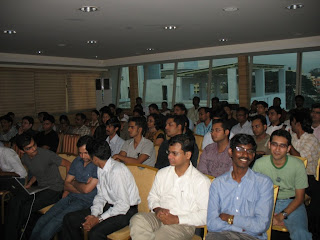"We are drawn to a body of knowledge, because it shed light on our identity as well as on the world. We did not merely find a subject; the subject also found us."
by APJ Abdul Kalam, former President and Chief Scientist of India!
The heavy rain that started at 5 in the evening did not stop anyone from attending the Eclipse Demo Camp. The overwhelming response from the eclipsers from the city resulted in 10 presentations, the organizers even had to cut down a few presentations as the evening could not hold more than 10 presentations. Around 50-60 eclipsers gathered for the event.
Let me start with my presentation - GEF3D. A concept to support 3D application development in Eclipse Editors. Jens Von Pilgrim, a research assistant from Fern University in Hagen, Germany conceptualized and implemented GEF3D. This was later supported by Kristian Duske with many more features in GEF3D.
The feature list provided by gef3d includes,
- Creation of 2D, 2.5D and 3D graphical editors.
- Connect between multiple graphical editors in 3D space (For example, you can connect a use case diagram and class diagram using connections or traces between them)
- Extend your existing GEF based 2D editors to 3D
GEF3D Team is planning a few more talks on the topic at various demo camps across Germany. Please visit http://eclipse.org/gef3d/ for more details.
Ankur Sharma presented Modelled UI in e4. It was amazing to see how you can model your UI with a few mouse clicks and model changes. If you want to try out e4, which is a re-written eclipse from scratch, check the e4 1.0M1 release. The first version e4 1.0 is scheduled to release sometime around June, 2010 (I guess).
Shubhvardhan from IBM talked about invoking eclipse controls from Visual Studio Add-ons.
Now more about, Twist and SWTBot. Ketan Padegaonkar presented the testing framework from ThoughtWorks - the 'Twist'. Its a functional testing tool which is a wrapper around SWTBot. Twist enables the tester to transform the indent of the business users (use cases) into automated tests.
Ms. Rajam from Infosys Technologies presented the Spring IDE using the MyEclipse Workbench. She travelled all the way from Chennai to present at the Bangalore Demo Camp. The spring IDE showed a perfect example for a language workbench. It reminds me the words from Martin Fowler on Language Workbenches.
Eclipse JDT Team Member Deepak Azad from IBM presented the new Javascript Development Toolkit (JSDT). Its a Javascript IDE based on the JDT framework. It includes most of the features provided by JDT, error markers, detailed flow analysis etc.
Pradeep Balachandran from IBM presented Jazz, the eclipse based new generation collaboration platform from IBM. The indent of Jazz is to make sure you follow the process during software development, and to ensure that you do not need to spend time with un-necessary documentations for the sake of following processes.
Ibrahim Quraish from Nokia, explained how to create widgets for S60 devices using the Nokia WRT Eclipse Plugins. Interestingly, the IDE used to present the topic was Aptana, not the Carbide IDE from Nokia, which is based on Eclipse. On further googling I could find out the list of IDEs Nokia uses for development.
Anil Gudise from Genuitec briefed about MyEclipseTools and Pulse. Ganeshraj from Hewlett Packard presented the C/C++ Remote Developer Plugin for Eclipse.
You can check the snaps at,
- http://picasaweb.google.com/grprakash/BangaloreDemoCampNov09
- http://picasaweb.google.com/madhusamuel/EclipseDemoCampBangalore2009
A few snaps are given below,

Myself In Action (Gef3D Presentation)

Ankur Sharma with e4

Room was packed with Eclipsers

Pradeep Balachandran explains Jazz

Ketan Padegaonkar (Twist and SWTBot)

Ms. Rajam explains Spring IDE

Shubhvardhan (Visual Studio - Eclipse Add-ons)
madhu

